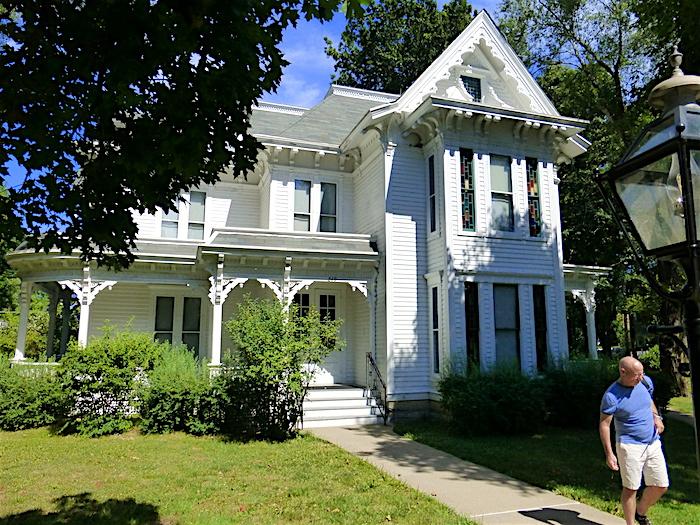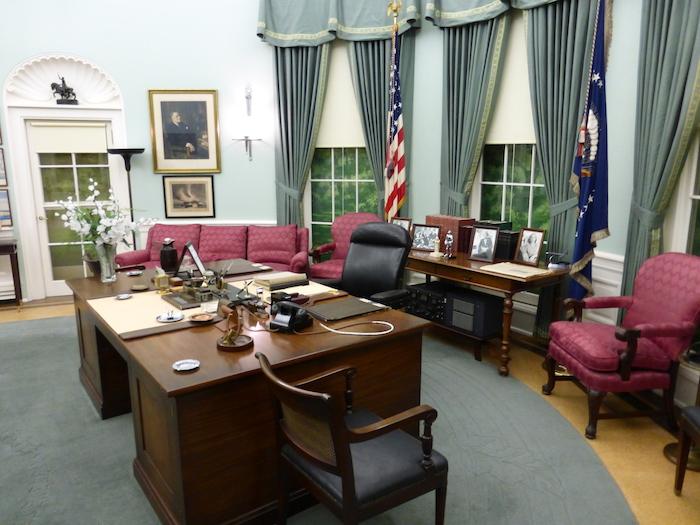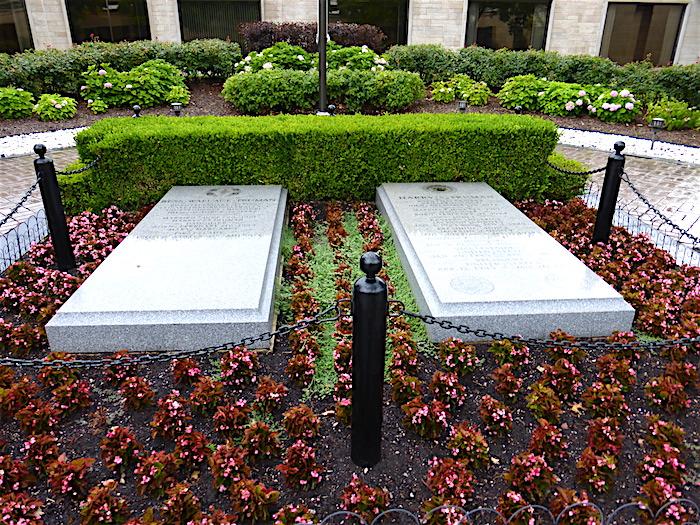
Harry S Truman's Independence, Missouri, home/David and Kay Scott
Harry S Truman was a true Missourian. It is the state where he was born and raised, where he met his wife to be, where he ran for public office, and where he chose to return following his presidency. Our 33rd president was born of modest means, worked as a businessman and farmer, and progressed up the political ladder from county judge, to U.S. Senator, Vice-President, and, upon the death of President Franklin Roosevelt, President of the United States. After it was all over, he returned to his home in Independence to live a down-to-earth life in the town he loved.
Truman was an unusual president in several respects, including residing with wife, Bess, in the same home for over five decades. Even though he spent time away from Independence during his years in Washington, their home in Missouri remained their real residence. Harry and Bess returned to their home at 219 N. Delaware Street following the end of his presidency. Following Truman’s death on December 26, 1972 at age 88, the former First Lady continued living at the same location until her passing a decade later, at which time the home was donated to the National Park Service. It is today as she left it over four decades ago.
The Early Life of Harry Truman
Harry Truman was born on May 8, 1884, in Lamar, Missouri, a small community northwest of Springfield near the Kansas border. The family, including a younger brother and sister, moved to Independence in 1890, in part so the three children would have access to better quality education.
During the early years in Independence Harry enjoyed typical childhood activities including reading, fishing, and hanging out with friends. At age 14, he took his first paid job working at a corner drug store on the town square. Following high school graduation in 1901, he tried several jobs before moving to Kansas City, where he was employed as a bank clerk.
In 1906, 22-year-old Harry Truman moved to Grandview to help with his grandparents’ family farm. Harry’s parents had moved back to the farm a year earlier following their own financial difficulties. Although the future president knew little about the business end of farming, he became the primary caretaker of the property following the 1914 death of his father. It was also during this period that Harry began spending considerable time courting his childhood sweetheart and future wife, Bess Wallace.
Harry Truman left the farm in 1917 when he rejoined a National Guard unit that had been federalized as an artillery regiment with the outbreak of World War I. The unit departed for France the following year and engaged in several major battles before the war ended. Truman, who rose to the rank of captain, was married to Bess Wallace soon after his return home from the war.

The Truman Musuem includes a replica of President Truman's Oval Office/David and Kay Scott
The Political Years
After the return home, Truman and a war-time buddy opened a clothing and accessories store that proved unsuccessful and closed in 1922. That same year he entered the political arena and, with backing from Democratic Party boss Thomas Pendergast, was elected district judge, a position that entailed overseeing the county’s public works and finances. Four years later he won election as the county’s presiding judge.
Truman was elected to the U.S. Senate in 1934, winning with an impressive margin over an incumbent republican. Reelected in 1940, he held the office until being selected in 1944 as President Franklin Roosevelt’s running mate. The pair won handily, although Truman served as vice president for just 82 days before assuming the presidency upon Roosevelt’s death.
Major events were not long in coming for the new president, who had met privately with Roosevelt on only a few occasions. Truman participated in the Potsdam Conference upon the surrender of Germany, approved the dropping of atomic bombs on Japan, and oversaw the country’s move from war to peace. He helped oversee the Marshall Plan that helped Europe achieve an economic recovery and initiated the Berlin airlift.
Truman won a surprise reelection in 1948 for another four years during which he participated in the creation of the North Atlantic Treaty Organization and sent U.S. military forces to the conflict in Korea. During this second term he presented the U.S. Congress with a full social legislative agenda including health care, civil rights, and public housing that proved to be premature and were unsuccessful.
Returning to Independence
Although eligible to run for another term as president, Truman decided not to run for reelection, in part because of his poor approval ratings near the end of his term. Following the inauguration of Dwight Eisenhower, the former president and wife Bess returned by train to Independence where they were welcomed at the station by a large contingent of citizens.
During the last two decades of his life, the former president worked on his memoirs, the first volume of which was published in 1955. He also oversaw construction of his presidential library that opened in 1957. Truman was especially well-known for his daily strolls around town, generally with little security until Secret Service protection was provided following the assignation of President John Kennedy. During these walks he enjoyed chatting with friends and visitors.
Harry Truman died on December 26, 1972, in a Kansas City hospital where he had been a patient for three weeks. His body laid in state at the Truman Library and was buried at a spot on the library grounds selected by the former president, who once commented that he hoped to be remembered as “the people’s president.”

The grave-site of President Truman and his wife, Bess/David and Kay Scott
The National Historic Site
In addition to the Truman home at 219 N. Delaware Street, the historic site includes the neighboring homes of Bess’s two brothers (acquired by NPS in 1991, although neither is open to the public), the home of Truman’s favorite cousins, the Nolands (open for self-guided tours), and the farm in Grandview (20 miles south of Independence and acquired in 1994), where Truman lived and worked for a decade. The farm grounds are open for self-guiding tours including a popular cell phone tour, however the home is closed to the public. The visitor center where tickets are sold for tours of the Truman home is located at 223 N. Main Street, six blocks east of the home. The small visitor center offers limited exhibits, a short film, and has brochures available.
A visit to the Truman Home should include time to enjoy a stroll through the neighborhood. The house used by Truman’s Secret Service detail is across the street from his home. The drug store near the visitor center where Truman once worked has been turned into an old-fashioned ice cream shop. Courthouse Square, also near the NPS visitor center, served as the starting point in the mid-1800s for many pioneers who blazed trails for America’s westward expansion.
The Truman home is open for guided tours daily except Mondays from 8:30 a.m. to 5 p.m. It is closed New Year’s Day, Thanksgiving, and Christmas Day. Tours last a half-hour and are limited to eight individuals per tour. Tickets are required and can be purchased ($5 adults; children 15 and under are free) at the NPS visitor center. No photography is permitted inside the home.
The Presidential Library and Museum
While presidential libraries and museums are operated by the National Archives and Records Administration rather than the National Park Service, they serve as a real treasure for those of us interested in America’s presidents. This is especially true for Harry Truman since the presidential library and museum is about 25 minutes from Truman’s home.
A visit to the museum deserves several hours and preferably half a day. Our suggestion would be to visit the museum prior to touring the Truman home in order to gain a greater understanding of Truman’s youth, his time as president, and the years of retirement in Independence. However, stop at the NPS visitor center and obtain tour tickets prior to driving to the museum.
The museum includes numerous galleries that offer insights into the various stages of Truman’s life. Also included are a replica of the White House Oval Office, a 45-minute film on the president’s life, and the grave-sites where Harry and Bess Truman are buried. We have been fortunate enough to visit a number of presidential libraries and have never been disappointed.
The museum is open 9 a.m. to 5 p.m. Monday through Saturday, and noon to 5 p.m. on Sunday. It is closed Thanksgiving, Christmas Day, and New Year’s Day. Admission is $8 for adults, $7 for seniors, and $3 for children age 5 to 16 years of age.



Comments
Truman is one of my favorite presidents. He really was a true salt of the earth American who met overwhelming obstacles and stepped up to some of the county's 'most challenging events.
Thanks for this most through article and for reminding us that the presidential libraries should not be overlooked when we have the opportunity to visit.
Kurt - from the article - "Secret Service protection was provided following the "assignation" of President John Kennedy."
Is that a Freudian slip or what?
This is the funniest thing I have ever seen on this site!
Like Alfred Hitchcock always made a short guest appearance in most of his movies, we always try to add at least on bit of hidden humor to our Traveler articles.